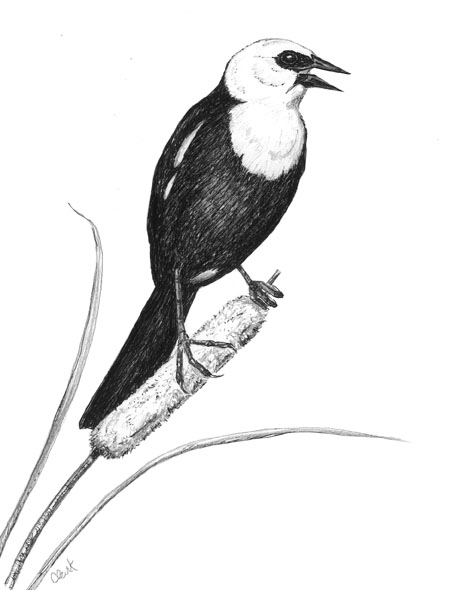
A Yellow-headed Blackbird comes to Truro:
I work with a fairly new and considerably younger staff these days, so whenever the phone rings, I tend to eavesdrop on the conversation. It’s not that I’m nosy (although I am); I just want to stay close in case I’m needed to help answer a question. Today when the phone rang, I heard a staff member respond to a caller by asking, “Do you really have a Yellow-headed Blackbird in your yard?” Whoa! My rare bird antenna immediately shot up. “I’ll take this one,” I said. The call was from Daisy in Truro. She told me that for the last few days she has had a Yellow-headed Blackbird in her yard. After gathering a bit of information, I asked Daisy if it would be okay if I stopped by to see the bird. Cheerfully, she replied that I was more than welcomed, which is a good thing, because I was heading there anyway.
Common in the Western states, Yellow-headed Blackbirds are rare visitors here in the East. Often when rare birds are discovered, they are “birders’ birds,” meaning normal folks wouldn’t ever notice them or ever care. The arrival of, say, a Red-necked Stint, a small sandpiper from Asia, would cause mass hysteria among birders, yet the rest of the human race wouldn’t even look at it twice, or even once for that matter. This is not the case with the Yellow-headed Blackbird. It’s a true attention getter. As the common name perfectly indicates, the male is black with a bright yellow head. It’s that simple. Even ornithologists, who often choose bewildering common names for birds, didn’t mess this one up…for a change.
With a population of eleven million, the Yellow-headed Blackbird is a successful species. They also aren’t fussy eaters, often chowing down lots of problematic insects. That makes the local farmers happy. But the birds will also eat newly planted crop seeds, and that makes the local farmers sad. And when a blackbird visits a field, it typically arrives in a flock consisting of thousands of its hungry relatives. As a result, the birds may be met with lethal measures. This might explain why the Truro bird decided to leave its normal range and spend a few days relaxing at Daisy’s place.
In addition to its distinctive black and yellow coloring, this bird has something else that separates it from all the other songbirds: its song…and not in a good way. The Yellow-headed Blackbird is frequently considered to be the worst avian singer in North America. When the male wants to advertise his territory, he will sit on a branch or cattail, twist his head back and produce a single harsh raspy note that sounds like a combination of my very first car trying to start and Bob Dylan. But as is the case with Dylan (but not my car), this awful sound actually gets the job done. A male Yellow-headed Blackbird may have as many as six mates at the same time. This is impressive and I’m sure he thinks the females are turned on by his handsome good looks. Wrong. The ladies are most likely attracted to his particular breeding territory instead. Once again, it’s location, location, location.
Within an hour after receiving Daisy’s phone call I pulled up to her house in Truro. I’m always a little nervous when going to someone’s house to look for a bird. I start to wonder if I have the correct address. Did I write it down wrong? Am I at 19 Main Street, when I am really supposed to be at 91 Main Street? Will I have to explain my mistake to the police or an irate homeowner, or run away from the family dog (which seems to happen no matter what)? In an effort to be extra cautious, I parked down the street and slowly walked toward the house, but two steps down the road I knew I had found the right address. Even though I couldn’t even see the house yet, I could hear, coming from a distant tree, the raspy sounds of a bird Bob Dylan.
In the summer, when the leaves are out, it’s often hard to find a bird in a tree, but not in this case. Right in the middle of a big mulberry tree (at least that’s what I’m calling it) was an obvious male Yellow-headed Blackbird. With absolutely no interest in me, the bird continued singing his lovely song (at least that’s what he’s calling it). At this point, Daisy came out of her house. Usually when an odd bird arrives in someone’s yard, the homeowner is excited (and rightly so) to talk about it. But Daisy thoughtfully kept her distance, not wanting to spook the bird before I could take a few photos. When I had finally finished snapping, she gave me a short tour of her bird-friendly yard. In addition to the Yellow-headed Blackbird, there were Eastern Towhees, Yellow Warblers, Chipping Sparrows and plenty of orioles. Daisy also pointed out that she owned some extra land, but very little of it had been disturbed. Most was left natural for wildlife. I liked Daisy.
Yellow-headed Blackbirds are unusual visitors to Cape Cod and when they do appear in our area, it’s nearly always in the fall. Seeing and hearing one in the spring was a treat. And even though this male’s song was loud and strong, it wasn’t quite loud enough to be heard by the nearest female Yellow-headed Blackbird, which was probably somewhere in Wisconsin. That might sound a little sad, but don’t worry; this bird won’t be alone. If he keeps singing his raspy song, he will likely attract a few more birders and also lots of confused music fans looking for Bob Dylan.